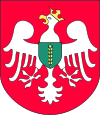Piotrków Trybunalski
Piotrków Trybunalski ([ˈpʲɔtrkuf trɨbuˈnalskʲi] (![]()
Piotrków Trybunalski | |
|---|---|
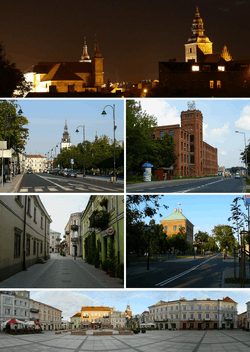 Night view of Old Town, Słowacki Street, Piotrkowska Manufaktura, street in Old Town, Royal Castle, Market Square | |
 Flag 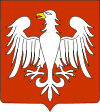 Coat of arms | |
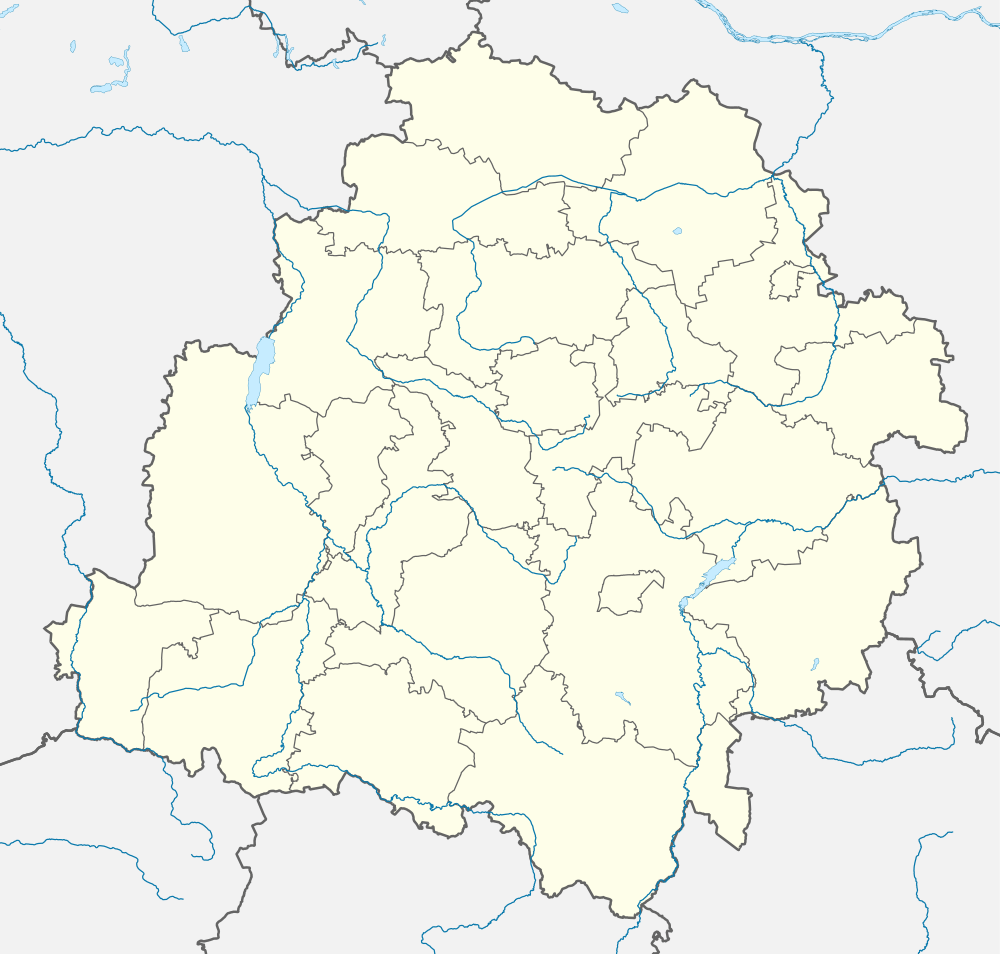 Piotrków Trybunalski  Piotrków Trybunalski | |
| Coordinates: 51°24′N 19°41′E | |
| Country | |
| Voivodeship | |
| County | city county |
| Established | before 1217 |
| Town rights | 13th century |
| Government | |
| • Mayor | Krzysztof Chojniak |
| Area | |
| • City | 67.27 km2 (25.97 sq mi) |
| Population (31 December 2019) | |
| • City | 73,090 |
| • Density | 1,095/km2 (2,840/sq mi) |
| • Metro | 200,000 |
| Time zone | UTC+1 (CET) |
| • Summer (DST) | UTC+2 (CEST) |
| Postal code | 97–300 to 97–312 |
| Area code(s) | +48 044 |
| Car plates | EP |
| Website | http://www.piotrkow.pl |
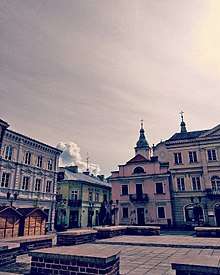
Etymology and other names
According to tradition, but not confirmed by historical sources, Piotrków was founded by Piotr Włostowic, a powerful 12th century magnate from Silesia. The name of the city comes from the Polish version of the name Peter (Piotr), in a diminutive form (Piotrek, or "Pete"). Trybunalski indicates that tribunal sessions (including the Crown Tribunal) were held in the town. The town has been known in Yiddish as פּעטריקעװ or Petrikev, in German as Petrikau, and in Russian as Петроков or Petrokov.
Location, demographics and statistics
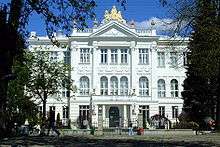
Piotrków Trybunalski is situated in the middle-west part (Piotrków Plains) of the Łódź Uplands. The population of the city is approximately 80,000 and its area is nearly 68 square kilometres (26 sq mi). The landscape of the Piotrków region and its geological structure was formed during the glaciation of 180,000–128,000 years ago. There are hardly any forests on the Piotrków Plains.
Two rivers cross the region, the Wolbórka and the Luciąża, which with their tributaries flow into the Pilica River and belong to the catchment area of the Vistula River. The watershed of Poland's two main rivers, the Vistula and the Oder (Odra), runs along the meridional line three km west of Piotrków. Two small rivers, the Strawa and the Strawka flow through the city, and it is between their valleys that the first settlement of Piotrków was founded in the early Middle Ages. Recently two more rivers have been included within the boundary of the city area - the Wierzejka, which in the western part of the city forms a reservoir, and the Śrutowy Dołek to the south of Piotrków.
The city is 200 m (656.17 ft) above sea level. The average temperature during the year is about 8 °C (46 °F), the coldest month is January (ranging from −20 to 2.5 °C (−4.0 to 36.5 °F)), the warmest is July (with 18 °C (64 °F) on average). Yearly rainfall is from 550 to 600 mm (22 to 24 in). The sandy soil of the region is not fertile.
History
Pre-modern history
In the early Middle Ages the Piotrków region was part of the province of Łęczyca ruled by the Piast dynasty. In c1264 it became part of a separate principality. The foundation of the city and its development were connected with its geographical position and the advantageous arrangement of the roads linking the provinces of Poland in Piast times. At first, a market town and a place of the princes' tribunals (in the 13th and 15th centuries), Piotrków became an administrative centre (the capital of the district since 1418), and in later centuries it also became an important political centre in Poland. The first record of Piotrków is in a document issued in 1217 by the Prince of Kraków, Leszek I the White, where there is a mention of the prince's tribunal held "in Petrecoue". Mediaeval Piotrków was a trading place on the trade routes from Pomerania to Russia and Hungary, and later from Masovia to Silesia.
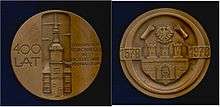
During the 13th century, apart from the tribunals, Polish provincial princes made Piotrków the seat of some assemblies of the Sieradz knights, which according to historical sources were held in 1233, in 1241, and in 1291. It might have been during the 1291 assembly that the Prince of Sieradz, Władysław I the Elbow-high, granted Piotrków civic rights, because in documents from the beginning of the 14th century he mentions "civitate nostra Petricouiensi".
The first certificate of foundation and the other documents were burnt in a great fire which destroyed the city around 1400. The privileges and rights were re-granted by King Władysław II Jagiełło in 1404. The city walls were built during the reign of King Casimir III, and after the great fire, they were rebuilt at the beginning of the 15th century. During the reign of Casimir III, many expelled German Jews from the Holy Roman Empire migrated to the town, which grew to have one of the largest Jewish settlements in the kingdom.
Between 1354 and 1567 the city held general assemblies of Polish knights, and general or elective meetings of the Polish Sejm (during the latter Polish kings of the Jagiellon dynasty were elected there). It was in the city of Piotrków that the Polish Parliament was given its final structure with the division into an Upper House and Lower Chamber in 1493. King John I Albert published his "Piotrków privilege" on May 26, 1493, which expanded the privileges of the szlachta at the expense of the bourgeoisie and the peasantry.
Piotrków became part of the Polish–Lithuanian Commonwealth in 1569. When the seat of the Parliament was moved to Warsaw, the town became the seat of the highest court of Poland, the Crown Tribunal, and trials were held there from 1578–1793; the highest Lithuanian court was held in Grodno. Piotrków's Jewish population was expelled in 1578 and only allowed back a century later. The town became a post station in 1684. Around 1705, German settlers (often Swabians) arrived in the town's vicinity and founded villages; they largely retained their customs and language until 1945.
While the importance of Piotrków in the political life of the country had contributed to its development in the 16th century, the city declined in the 17th and 18th centuries, due to fires, epidemics, wars against Sweden, and finally the Partitions of Poland.
The first official inventory of important buildings in Poland, A General View of the Nature of Ancient Monuments in the Kingdom of Poland, led by Kazimierz Stronczynski from 1844–55, describes the Great Synagogue (Piotrków Trybunalski) as one of Poland's architecturally notable buildings.[2]

Modern history
In 1793, the Kingdom of Prussia annexed the town in the Second Partition of Poland and administered it as part of the Province of South Prussia. During the Napoleonic Wars, Piotrków became part of the Duchy of Warsaw (1807–15) and was a district seat in the Kalisz Department. After the defeat of Napoleon in 1815, Piotrków became part of Congress Poland, a puppet state of the Russian Empire. The town was made the seat of an oblast.
When the Warsaw-Vienna railway was built in 1846, there was a slight increase in the economic and industrial development of Piotrków. In 1867 the Russian authorities formed the Oblast (province) of Piotrków, which included Łódź, Częstochowa, and the coal fields of Dąbrowa Górnicza and Sosnowiec. According to the Russian census of 1897, out of the total population of 30,800, Jews constituted 9,500 (around 31% percent).[3] The province had the best developed industry of all of Congress Poland until 1914. Many Poles demonstrated and went on strike during the 1905 Russian Revolution.
During World War I, Piotrków was occupied by Austria-Hungary. From 1915–16, it was a centre for Polish patriotic activity. The city was a seat of the Military Department of the National Committee, and a headquarters for the Polish Legions, which were voluntary troops organized by Józef Piłsudski, Władysław Sikorski and others to fight against Russia. Piotrków was made part of the Second Polish Republic following the defeat of the Central Powers in the war.
In the interwar period, Piotrków was the capital of Piotrków County in the Łódź Voivodeship, and lost its previous importance. In 1938 the town had 51,000 inhabitants, including 25,000 Jews and 1,500 Germans. The town had a large Jewish settlement and until the Holocaust a thriving Hebrew printing and publishing industry.
World War II
During the invasion of Poland at the beginning of World War II, Piotrków was the setting for fierce fighting between the Polish 19th Infantry Division and the 16th Panzer Corps of the German Wehrmacht on September 5, 1939. The town was occupied by Nazi Germany for the following six years.
As early as October 1939 Piotrków became the site of the first Jewish ghetto of World War II set up in occupied Poland. Approximately 25,000 people from Piotrków and the nearby towns and villages were imprisoned there. During the Holocaust 22,000 were sent to the Nazi Treblinka extermination camp, while 3,000 were imprisoned in other Nazi concentration camps.
From the first months of the war, Piotrków was a centre for underground resistance. From the spring of 1940, it was the seat of the district headquarters of the Armia Krajowa, or Home Army. In the summer of 1944, the 25th Infantry Regiment of the Home Army was formed in the district; it was the largest military unit of the Łódź Voivodship, and fought against the Germans until November 1944. In the city and district, there were also other partisan groups: the Military Troops (connected with the Polish Socialist Party), People's Guard and People's Army (Polish Workers' Party), Peasants' Battalions (Polish People's Party), the National Military Organization and the National Armed Forces (National Party).
On January 18, 1945, the Soviet Red Army entered the city, dislodging the German troops. Anti-communist partisans continued to fight in the vicinity in the following years. From 1949–70, Piotrków was built into an industrial centre.

Piotrków was a district capital in the Łódź Voivodeship, until 1975. Then, following the changes in the administrative division of the country, the city became the capital of the new Piotrków Voivodeship, thus regaining the status of an important administrative, educational and cultural centre of Poland. In 1999, the Piotrków Voivodship was dissolved and Piotrków became the capital of Piotrków County within the Łódź Voivodship.
Economy
Piotrków, thanks to its location, is known as the second largest "logistic centre" after Warsaw. There is a high concentration of warehouses and distribution centres around the city. The biggest distribution centres are:
- Prologis Park Piotrkow I and Prologis Park Piotrkow II owned by ProLogis
- IKEA Distribution Centre owned by IKEA
- Logistic City – Piotrków Distribution Centre owned by local concern Emerson
- Poland Central
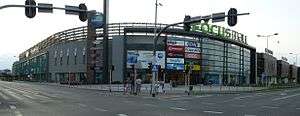
In Piotrków are also located:
- Emerson Polska – self-copying computer paper
- Häring – facility producing fuel injection equipment (for Mercedes-Benz, Bosch, Volkswagen)
- Metzeler Automotive Profile Systems – car profiles
- Kiper brewery
- FMG Pioma S.A. – mining machinery, conveyor belts
- Sigmatex Sp. z o.o. – knitted fabrics
and many small and medium textile processing factories.
Transport

Piotrków lies almost in the centre of Poland. It has a train station on the line from Warsaw to Częstochowa. Direct trains go among others to Cracow, Zakopane, Katowice, Bielsko-Biała, Wrocław, Łódź, Poznań, Szczecin, Świnoujście, Gdynia, Olsztyn and Białystok.
Roads
One expressway and two national roads cross Piotrków:



Airports
There is a small airfield for light passenger aircraft in Piotrków. The nearest airport is Łódź Władysław Reymont Airport in Łódź. Two large international airports are Warsaw Frédéric Chopin Airport about 133 km (83 mi) from Piotrków and Katowice International Airport about 137 km (85 mi) from Piotrków.
Educational institutions
- Wyższa Szkoła Handlowa in Piotrków Trybunalski
- Wyższa Szkoła Kupiecka in Łódź, branch in Piotrków
- Jan Kochanowski University in Kielce, branch in Piotrków
- Bolesław I the Brave High School in Piotrków Trybunalski
Politics

Piotrków Trybunalski/Skierniewice constituency
Members of Parliament (Sejm) elected by the Piotrków/Skierniewice constituency
- Antoni Macierewicz, Law and Justice
- Dariusz Seliga, Law and Justice
- Marcin Witko, Law and Justice
- Robert Telus, Law and Justice
- Elżbieta Radziszewska, Civic Platform
- Dorota Rutkowska, Civic Platform
- Marek Domaracki, TR
- Jacek Nibliecky, NPD
- Krystyna Ozga, PSL
- Artur Ostrowski, SLD
Sports
- Piotrcovia Piotrków Trybunalski – women's and men's handball team playing in the Polish Ekstraklasa Women's Handball League and the Polish Ekstraklasa Men's Handball League
- Concordia Piotrków Trybunalski – men's football team playing in the third league: Third place in the 2006/2007 season.
Notable residents
- Ernestine Rose (1810–1892), feminist writer and human rights activist
- Chaim Elozor Wax (1822–1887), famous rabbi
- Władysław Biegański (1857-1917), medical doctor, philosopher and social activist
- Stefan Rowecki (1895–1944), general
- Thaddeus Wronski (1887–1965), opera singer and conductor, founder and director of the Detroit Civic Light Opera
- Adam Muszka (1914–2005), painter and sculptor
- Moshe Bromberg (1920-1982), Polish-Jewish painter
- Alice Miller (1923-2010), psychologist
- John Michael Małek (1928) was born in Piotrków Trybunalski
- Ben Helfgott (1929-), Polish-born British weightlifter
- Yisrael Meir Lau (born 1937), Ashkenazi Chief Rabbi of Israel
- Maciej Ganczar (born 1976) literary scholar specializing in German literature, literary translator
- Wojciech Szala (born 1976), footballer
- Wioletta Frankiewicz (born 1977), runner
- Michał Bąkiewicz (born 1981), volleyball player
- Michał Jonczyk (born 1992), footballer
- Mariusz Trynkiewicz (born 1962), Polish serial killer
International relations
Twin towns – sister cities
Piotrków Trybunalski is twinned with:
|
|
Piotrków Trybunalski is also partnered with:
Image gallery
- Church in Piotrków Trybunalski
 Angel in a graveyard in Piotrków
Angel in a graveyard in Piotrków- Parish church in Piotrków as seen from Stefan Czarniecki Square
- Grodzka street near the old Market Square
- Szewska street on Old Town
- Royal castle in Piotrków
- Remaining old city walls
- Former Synagogue
- Former "Piotrkowska Manufaktura"
 Water tower near railway and bus stations
Water tower near railway and bus stations St. James Parish Church
St. James Parish Church- Bernardine Monastery
References
- "Local Data Bank". Statistics Poland. Retrieved 5 July 2020. Data for territorial unit 1062000.
- Heaven's Gates; Wooden synagogues in the Territories of the Former Polish-Lithuanian Commonwealth, Maria and Kazimierz Piechotka, Wydawnictwo Krupski i S-ka, Warsaw, 2004, p. 174
- Joshua D. Zimmerman, Poles, Jews, and the politics of nationality, Univ of Wisconsin Press, 2004, ISBN 0-299-19464-7, Google Print, p.16
- "Neath Port Talbot Twin Towns". Neath Port Talbot County Borough Council. Archived from the original on 2013-08-22. Retrieved 2013-08-22.
External links
| Wikivoyage has a travel guide for Piotrków Trybunalski. |
| Wikimedia Commons has media related to Piotrków Trybunalski. |


